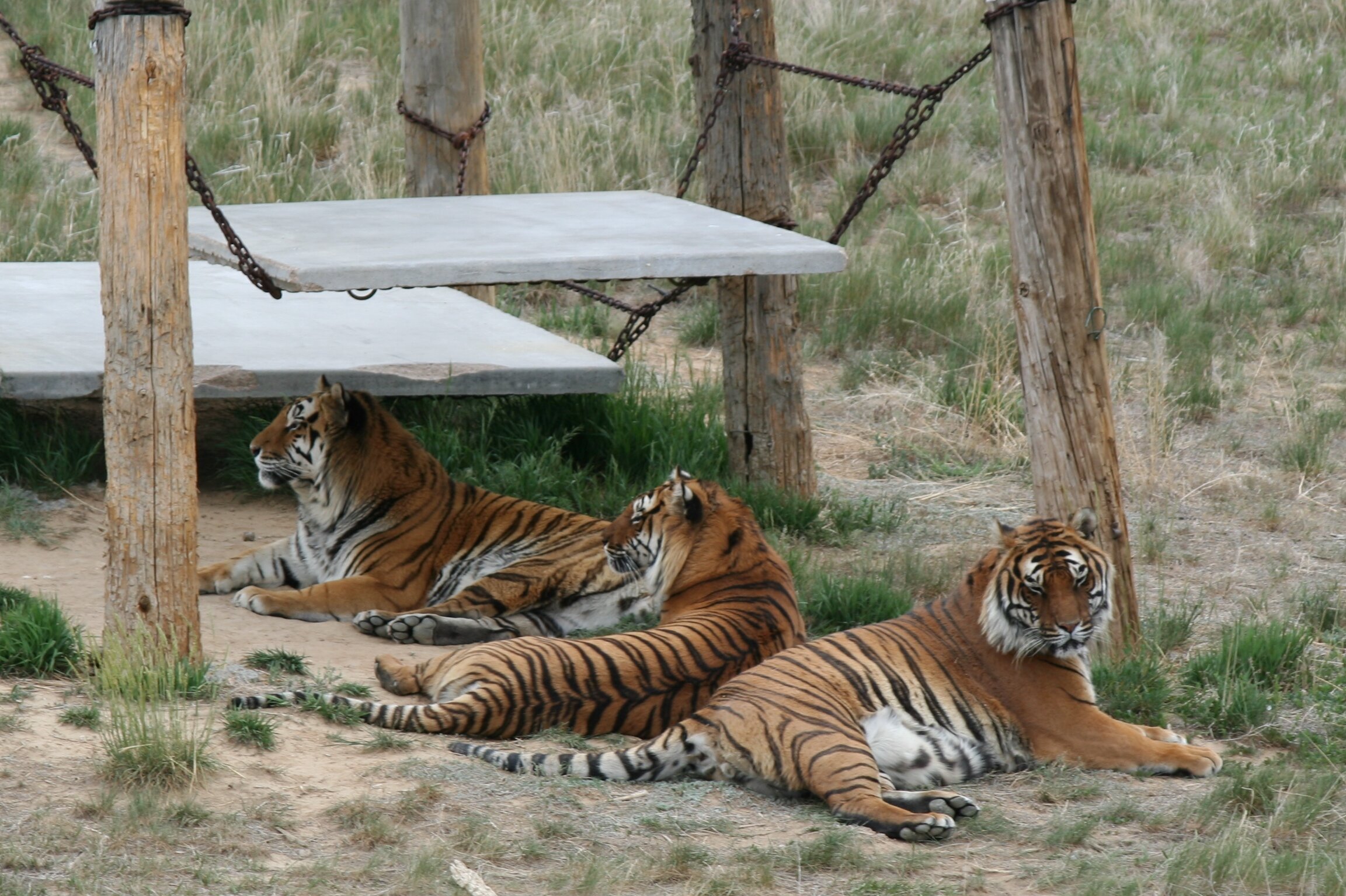After Tiger King: Colorado's The Wild Animal Sanctuary saves tigers and other large carnivores
Welcome to The Wild Animal Sanctuary in Keenesburg, Colorado. Photo by Carrie Dow.
Like much of the nation, I was transfixed watching Netflix’s popular documentary series Tiger King. While fascinated by the outrageous personalities and bad behavior, my main concern was, what happened to all those animals? I was relieved to learn that many animals belonging to Joe “Tiger King” Exotic ended up at one of the country’s best known wildlife rescues, The Wild Animal Sanctuary of Colorado.
The Wild Animal Sanctuary (TWAS) is the oldest and largest carnivore rescue facility in the United States. It was founded in 1980 by Executive Director Pat Craig, who at the age of 19 took in healthy adult tigers from zoos who were going to be euthanized simply because they were too expensive to keep. Quickly outgrowing his land in Boulder, he eventually moved to Keenesburg in 1994. That location sits on 789 uninterrupted acres on the high plains of the Colorado Plateau with views of the Rocky Mountains.
The indoor enclosure is for the Bolivian lions, who came from a warmer climate. TWAS provided a heated indoor space for them during Colorado winters. They can come and go from the building as they please. Photo by Carrie Dow.
The sanctuary came to national attention in 2011 when they accepted 25 lions confiscated from illegal circuses in Bolivia. Former Price Is Right host Bob Barker donated $2 million to charter a plane from South American to Denver for the lions. TV stations across the country broadcast the plane landing and the animals being moved to their new home.
The dangers of exotic pet ownership entered the spotlight again after a man in Zanesville, OH, turned loose his collection of 56 exotic animals before killing himself. Forty-eight animals were killed by law enforcement in order to protect the public. Because of existing state law at the time, the six surviving animals were actually given back to the man’s widow. It took several months of negotiations before the animals arrived at TWAS.
Craig began rescuing unwanted tigers after visiting a friend who worked at a North Carolina zoo. He saw several adult tigers in tiny cages in rooms away from public view. When he asked why the animals were kept like that his friend explained that most visitors only wanted to see baby tigers. When they got too big or too old, they were removed from view and because they were so expensive to feed, most were euthanized, a common practice in zoos in the 70s and 80s. Disgusted at the thought of perfectly healthy animals being killed for no reason he began asking zoos if he could have the tigers they didn’t want anymore. His vision at the time was sort of a tiger retirement home. Changes to laws and regulations of zoos have stopped that practice and breeding in zoos is highly regulated, however, because of lax laws in many states, tigers in private attractions or kept as pets are completely unregulated, being forced to breed (often inbred), litter after litter, and then destroyed when they out-grow their ability to make money. Saving these animals and giving them a better life is now the sanctuary’s purpose.
The TV series had an impact on the rescue and just recently People Magazine published an interview with TWAS public relations director Kent Drotar. It turned out the rescue was quite familiar with Joe Exotic and already had 39 of his tigers and three bears.
TWAS is home to bears too. Photo by Carrie Dow.
I emailed Drotar to see if TWAS had seen an uptick in donations because of the show. Drotar said there had been, but because of uncertainty about COVID-19 and quarantines, that could change. He also said that the sanctuary was glad Joe Exotic and his co-horts were profiled because the entire country was now aware of what TWAS and other animal welfare groups had known for years, tigers as pets and cub petting were harmful.
“We have always believed that if you try to tell someone that there are people like this, they would not believe you because it is just unfathomable how they are and what they do,” he wrote. I also asked if the show will help curb the practice of cub petting or increase demand.
“Unfortunately, a little of both,” he responded. “Yes, people will become more aware of such practices and the downside of them. However, there are enough people out there that will be enamored by the possibility of petting a cub. As you would imagine, our hope is that the practice of cub petting will decrease.”
Chillaxin’ tigers. Photo by Carrie Dow.
To that end Drotar hoped public awareness will help pass the Big Cat Public Safety Act currently before Congress and mentioned in the show. Drotar and TWAS were hopeful that enough people’s eyes were opened to the outlandish and selfish behavior of people breeding tiger cubs for profit.
Craig, while speaking at an event in Lone Tree, CO, several years ago talked about the delicate balance required to run this kind of rescue. He said the best life for these animals was the less human contact, the better. The sanctuary didn’t even allow visitors its first 20 years of existence. In 2001 Craig and his staff decided that having visitors in a highly controlled environment would not only provide some revenue, but allow the sanctuary to take on a much needed educational role by teaching people about the dangers of keeping wild animals as pets.*
A walk into the wild; the elevated walkway at TWAS is the world’s longest. Photo by Carrie Dow.
Visitors are restricted to elevated walkways above the habitats. In fact, the sanctuary is listed by Guinness as the longest elevated walkway/footbridge in the world at 1.45 miles. The walkway keeps visitors from being eye level with the animals, especially big cats, because looking a lion or tiger in the eye agitates them and they consider eye contact a threat. Instead of living in cages, animals are housed in open habitats anywhere from 3 to 16 acres depending on the species and size. Lions are kept in prides and tigers who get along are also put together. There is no breeding at the sanctuary; all animals are neutered except for lions. Because a neutered male lion will lose its beautiful mane, the sanctuary instead uses contraception on female lions. Bears at the sanctuary have underground dens where they can hibernate during winter. None of the animals have human contact except for medical purposes. Animals are fed from vans so they won’t associate humans with food. To them it simply falls out of a vehicle.
Now that most of the country has seen Tiger King and the terrible conditions these animals live in, TWAS’ mission is even more critical and why they continue to expand. In 2018, the sanctuary purchased an additional 9,684 acres in southcentral Colorado bringing their total land to over 10,000 acres. This new space will hold many more rescued animals in habitats from 5 to over 300 acres in the future.
TWAS is a non-profit 501c3 that is accredited by the Global Federation of Animal Sanctuaries. The sanctuary is home to a menagerie of over 500 animals including wolves, coyotes, fox, jaguars, lynx, mountain lions, raccoons, coati mundi, alpacas, and even a camel, emu, and ostriches.
* It is incredibly expensive to house and feed adult carnivores. According to World Wildlife Fund it costs anywhere from $7,500-10,000 in food and medical care per animal per year for the largest – lions and tigers. TWAS states on its website that visitor entry fees ($30 for adults/$15 for children 3-12) only cover the cost of hosting visitors. The sanctuary relies solely on donations to feed and care for the animals.
Photo by Carrie Dow.












